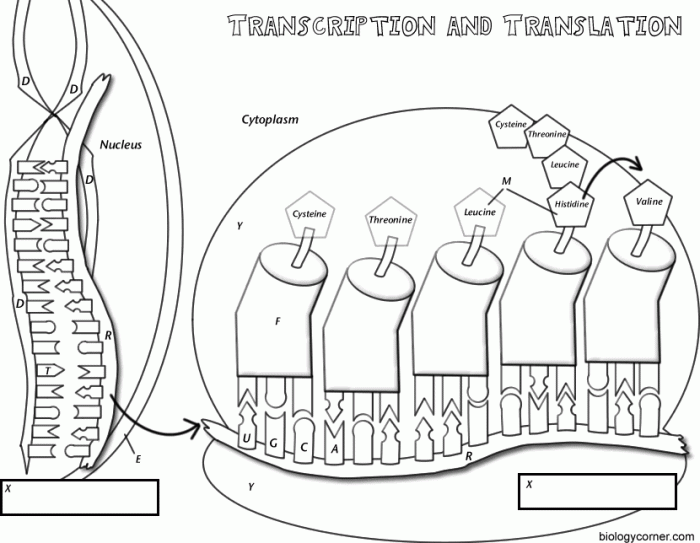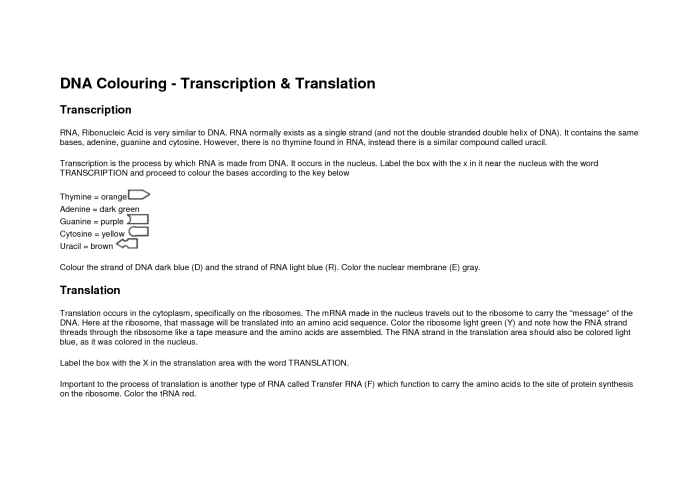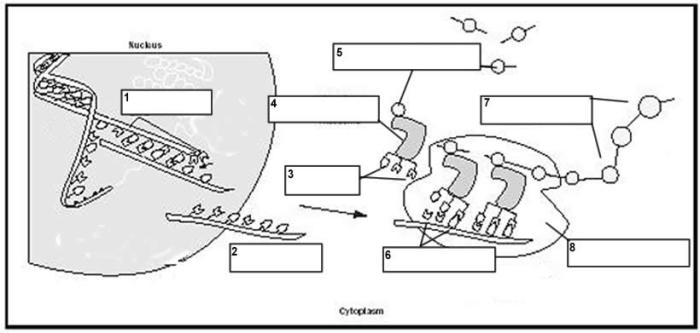Immerse yourself in the captivating realm of transcription and translation coloring worksheets, where language learning transcends traditional boundaries. These innovative resources seamlessly integrate visual stimulation and linguistic practice, unlocking a world of enhanced comprehension and proficiency.
Within this comprehensive guide, we delve into the intricacies of transcription and translation, illuminating their distinctive roles in language acquisition. We explore the diverse types of coloring worksheets available, demonstrating how they can effectively support both transcription and translation practice.
Transcription and Translation
In the context of language learning, transcription refers to the process of converting spoken language into written form, while translation involves converting written or spoken language from one language to another.
Differences Between Transcription and Translation
- Focus:Transcription focuses on accurately representing the sounds of a language in written form, while translation aims to convey the meaning of a text in a different language.
- Output:Transcription produces a written record of the spoken language, whereas translation results in a text that is both comprehensible and culturally appropriate in the target language.
- Skills Required:Transcription requires strong listening and writing skills, while translation demands proficiency in both the source and target languages.
Benefits of Transcription and Translation in Language Learning
- Improved Listening Comprehension:Transcription helps learners develop better listening skills by forcing them to focus on the sounds of the language.
- Enhanced Writing Skills:Translation exercises improve writing skills by requiring learners to produce accurate and meaningful text in the target language.
- Vocabulary Expansion:Both transcription and translation expose learners to new vocabulary and phrases, expanding their linguistic repertoire.
- Cultural Understanding:Translation helps learners gain insights into the culture and perspectives of the target language community.
Coloring Worksheets

Coloring worksheets are a versatile tool that can be used to support both transcription and translation practice.
Types of Coloring Worksheets
- Transcription Worksheets:These worksheets contain texts in the target language, with instructions to color certain words or phrases based on their transcription.
- Translation Worksheets:These worksheets present texts in both the source and target languages, with instructions to color the corresponding words or phrases in each language.
How Coloring Worksheets Support Transcription and Translation Practice
- Visual Reinforcement:Coloring helps learners visually associate sounds and words, improving their ability to transcribe and translate.
- Cognitive Engagement:The interactive nature of coloring worksheets keeps learners engaged and motivated.
- Self-Assessment:Coloring worksheets provide immediate feedback, allowing learners to assess their own progress.
Using Coloring Worksheets in the Classroom
- Transcription Practice:Assign transcription worksheets as homework or in-class exercises, encouraging learners to focus on the sounds of the language.
- Translation Practice:Use translation worksheets to practice vocabulary and sentence structure, highlighting the differences between the source and target languages.
- Differentiation:Coloring worksheets can be differentiated based on difficulty, allowing learners to work at their own pace and level.
Activities for Transcription and Translation

Activity for Transcription Practice
Provide a coloring worksheet with a short audio clip in the target language. Instruct learners to listen to the clip and color the corresponding words or phrases on the worksheet.
Activity for Translation Practice
Create a coloring worksheet with a text in both the source and target languages. Ask learners to color the corresponding words or phrases in each language, matching the meaning.
Lesson Plan Incorporating Transcription and Translation Coloring Worksheets
- Introduction:Begin with a brief explanation of transcription and translation.
- Transcription Practice:Distribute transcription worksheets and play the audio clip.
- Translation Practice:Hand out translation worksheets and have learners complete the matching exercise.
- Discussion:Lead a class discussion on the differences between transcription and translation.
- Assessment:Collect the worksheets for assessment.
Assessment

Transcription and translation coloring worksheets can be used to assess student progress in various ways.
Assessment Criteria
- Accuracy:Check if learners have correctly transcribed or translated the words or phrases.
- Completeness:Ensure that learners have completed all the required tasks on the worksheet.
- Visual Presentation:Assess the clarity and organization of the coloring work.
Grading Rubric
| Criteria | Excellent | Good | Fair | Poor |
|---|---|---|---|---|
| Accuracy | All words/phrases transcribed or translated correctly | Most words/phrases transcribed or translated correctly | Some words/phrases transcribed or translated correctly | Few words/phrases transcribed or translated correctly |
| Completeness | All tasks completed | Most tasks completed | Some tasks completed | Few tasks completed |
| Visual Presentation | Clear and organized coloring | Mostly clear and organized coloring | Somewhat clear and organized coloring | Unclear and disorganized coloring |
General Inquiries: Transcription And Translation Coloring Worksheet
What are the key differences between transcription and translation?
Transcription involves converting spoken language into written form in the same language, while translation entails converting written or spoken language from one language into another.
How can coloring worksheets enhance transcription practice?
Coloring worksheets provide a visual representation of the spoken language, aiding in the recognition and recall of unfamiliar words and phrases.
What types of assessment criteria can be used to evaluate student work on transcription and translation coloring worksheets?
Criteria may include accuracy of transcription or translation, vocabulary knowledge, grammar usage, and overall comprehension.